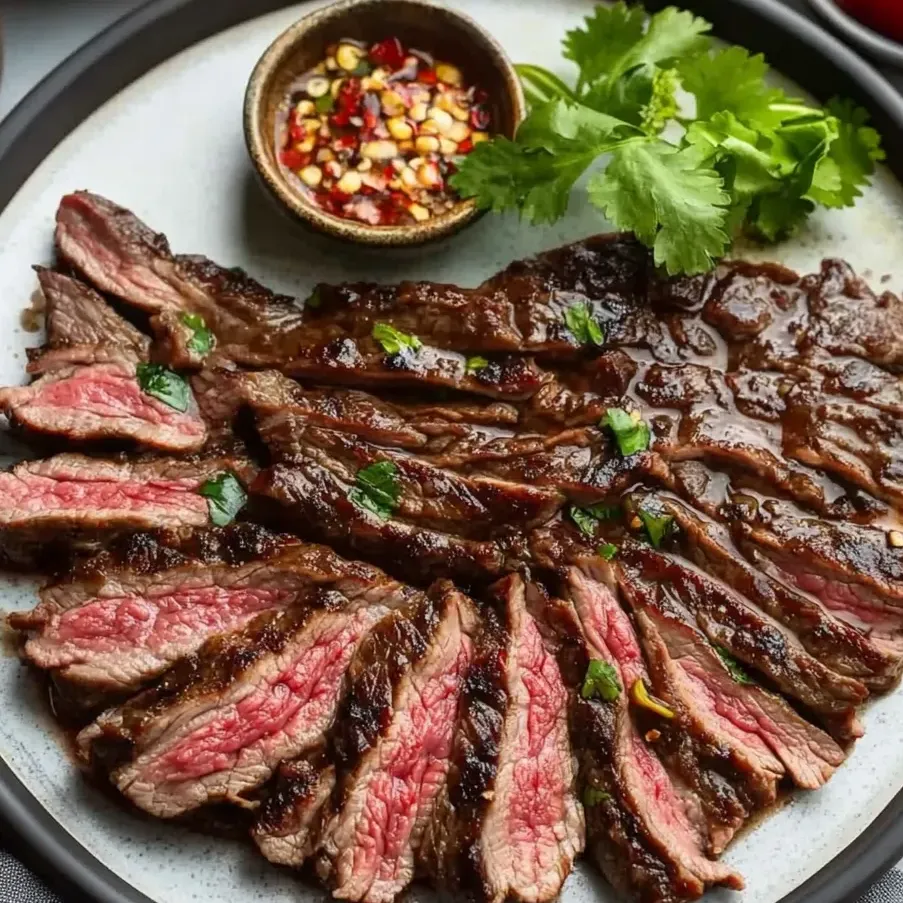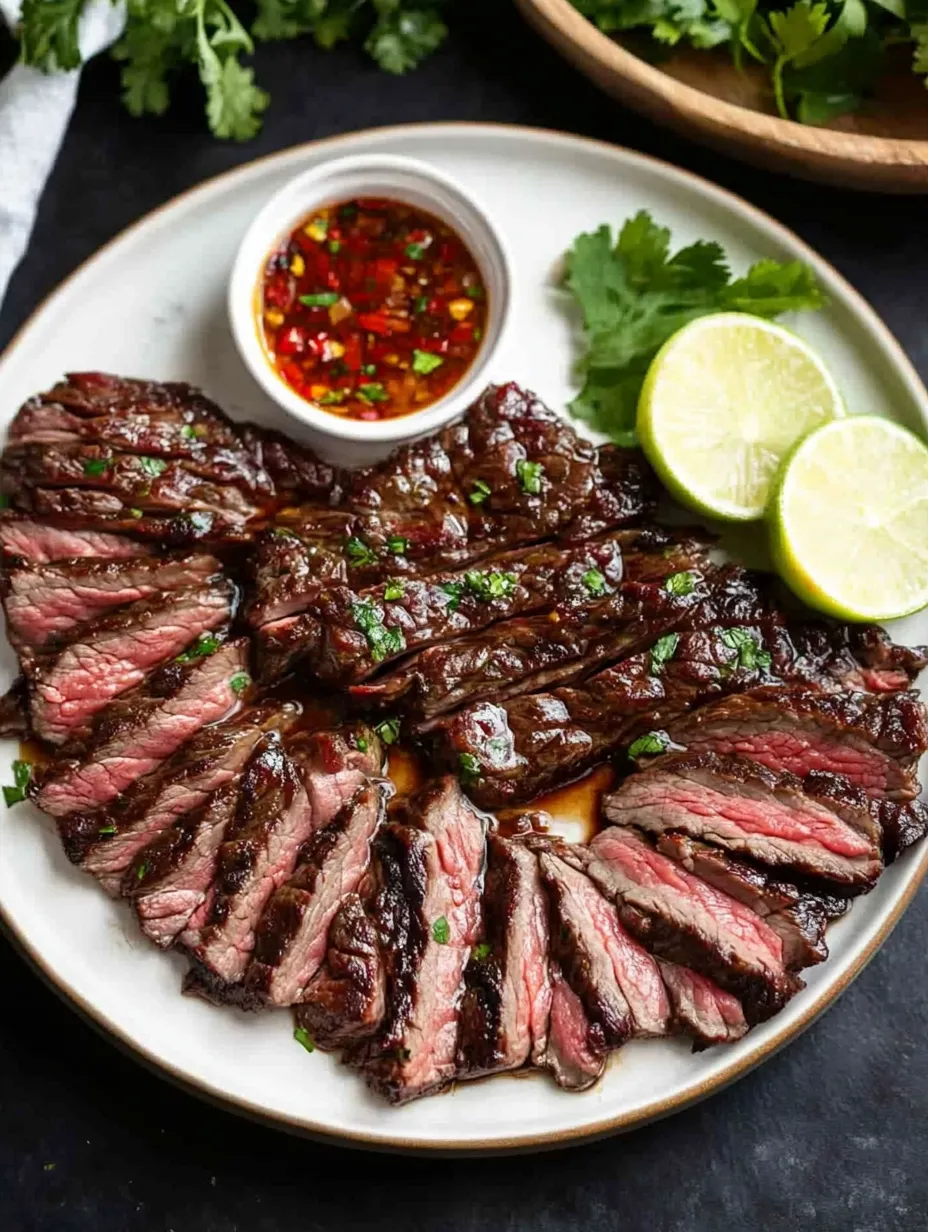 Save
Save
This savory Thai Crying Tiger steak recipe delivers restaurant-quality flavor with minimal effort. The combination of perfectly seared beef and tangy dipping sauce creates an unforgettable meal that balances sweet, sour, salty and spicy notes in true Thai fashion.
I discovered this recipe during my travels through Thailand and have perfected it over dozens of dinner parties. The moment guests taste that first bite dipped in the sauce, their eyes widen with delight every single time.
Ingredients
- Ribeye steak: Provides the perfect marbling for this dish. The fat content melts during cooking creating an incredibly juicy result
- Oyster sauce: Adds umami depth to the marinade. Look for bottles listing oysters as the first ingredient for best quality
- Palm sugar: Contributes authentic caramel notes. If substituting brown sugar choose dark for closer flavor profile
- Tamarind pulp: Brings essential sourness. Purchase blocks in Asian markets for the truest flavor
- Rice powder: Thickens the sauce and adds subtle nuttiness. Toasting it yourself makes all the difference
- Thai chili flakes: Deliver the signature heat. Adjust quantity based on your spice tolerance
Step-by-Step Instructions
- Marinate the Steak:
- Combine oyster sauce, palm sugar, lime juice, soy sauce, minced garlic and oil in a bowl. Whisk until sugar dissolves completely. Add steak and massage marinade into meat ensuring every surface is coated. Let rest for 15 minutes at room temperature which allows the meat to relax and absorb flavors while taking the chill off for more even cooking.
- Prepare Tamarind Base:
- Pour boiling water over tamarind pulp in a small bowl. Allow it to soften for about 2 minutes until you can easily mash it with a fork. Work the pulp thoroughly with your fingers separating all the flesh from the seeds and fibers. Press mixture through a fine sieve collecting only the smooth paste. This creates the sour foundation of your dipping sauce.
- Toast Rice Powder:
- Add raw rice to a completely dry skillet over medium heat. Move rice constantly to prevent burning watching for it to turn golden brown and release a nutty aroma usually about 3 to 4 minutes. Grind immediately while still warm into a fine powder using a spice grinder or mortar and pestle. The freshly toasted rice adds both texture and a subtle smoky flavor to the dipping sauce.
- Create Dipping Sauce:
- Combine prepared tamarind paste, ground rice powder, palm sugar, diced shallots, chopped cilantro, fish sauce, lime juice and chili flakes in a bowl. Stir vigorously until sugar dissolves and ingredients are fully incorporated. Let sit for at least 5 minutes for flavors to meld and develop complexity. The sauce should taste balanced with no single flavor dominating.
- Sear the Steak:
- Heat a heavy skillet until extremely hot almost smoking. Add oil and carefully place marinated steak in pan. Allow to cook undisturbed for 3 to 4 minutes developing a deep brown crust. Flip and repeat on second side. The high heat caramelizes the sugars in the marinade creating complex flavors while sealing in juices.
- Rest and Slice:
- Transfer cooked steak to a cutting board and let rest for a full 10 minutes. This critical step allows juices to redistribute throughout the meat. Slice thinly against the grain at a slight angle to ensure tenderness. Arrange slices on a serving platter with dipping sauce on the side for the perfect presentation.

Best Cuts of Beef for Crying Tiger
While ribeye is traditional for this recipe any well marbled cut works beautifully. Flat iron steak offers excellent flavor at a lower price point making it my weeknight go to option. Flank steak needs a longer marinade time about 2 hours but rewards with spectacular texture. Whatever cut you choose maintain the 1 inch thickness for optimal cooking results and aim for high quality meat since it truly is the star of this dish.
Serving Suggestions
In Thailand Crying Tiger is traditionally served with sticky rice which helps balance the heat of the dipping sauce. A simple cucumber salad makes the perfect cooling side dish. For a complete Thai feast consider adding papaya salad or tom yum soup as starters. Always serve with extra lime wedges and additional chili flakes on the side allowing guests to adjust flavors to their preference. This recipe easily scales up for larger gatherings.

Storage Information
The cooked steak keeps refrigerated for up to 3 days in an airtight container. For best results slice only what you plan to eat immediately and store remaining portions whole to preserve juiciness. The dipping sauce can be refrigerated separately for up to 1 week though the flavors are most vibrant within the first 48 hours. If the sauce thickens too much after refrigeration simply thin with a splash of lime juice or water. Never freeze the dipping sauce as the texture will deteriorate.
Quick Ingredient Substitutions
No tamarind pulp available? Use 2 teaspoons Worcestershire sauce plus 1 teaspoon lime juice to approximate the flavor. Missing fish sauce? Substitute with light soy sauce mixed with a small amount of anchovy paste. Regular jasmine rice works perfectly fine for the toasted rice powder if glutinous rice is unavailable. For a vegetarian version substitute the ribeye with grilled king oyster mushrooms sliced into steaks and replace fish sauce with soy sauce plus a pinch of mushroom powder for umami depth.
Frequently Asked Cooking Questions
- → What cut of beef works best for Crying Tiger?
Rib eye, strip sirloin, flat iron, and flank steak all work well for Crying Tiger. The key is choosing a cut that's about 1-inch thick and has good marbling for flavor. Flank steak is more economical but benefits from slightly longer marinating time, while rib eye offers the richest flavor profile.
- → What is toasted rice powder and why is it important?
Toasted rice powder (khao khua) is a key ingredient in Thai cuisine made by dry-toasting uncooked rice until golden brown, then grinding it into a powder. It adds a unique nutty flavor and subtle thickening texture to the dipping sauce. This ingredient is essential for authentic Crying Tiger sauce as it provides both flavor and body.
- → Can I make this dish less spicy?
Yes, you can easily adjust the spice level by reducing or omitting the Thai chili flakes in the dipping sauce. For a milder version, start with just a pinch of chili flakes and adjust to taste. You can also serve additional chili flakes on the side for those who prefer more heat.
- → What should I serve with Crying Tiger?
Traditional accompaniments include sticky rice, papaya salad (som tam), and fresh vegetables like cucumber slices, cabbage, and Thai basil. For a complete Thai meal, add a light soup like tom yum. The cool, crisp vegetables provide a refreshing contrast to the rich beef and spicy sauce.
- → Can I prepare the dipping sauce in advance?
Yes, the dipping sauce can be prepared up to 3 days ahead and stored in an airtight container in the refrigerator. The flavors will actually meld and develop over time. Just bring it to room temperature before serving and give it a good stir, as the rice powder may settle at the bottom.
- → Is there a vegetarian alternative to this dish?
The beef can be replaced with firm tofu, portobello mushrooms, or seitan for a vegetarian version. Marinate these alternatives just as you would the beef, substituting vegetarian stir-fry sauce for the oyster sauce and using mushroom-based soy sauce instead of fish sauce in the dipping sauce. The cooking time will vary based on your chosen protein.
